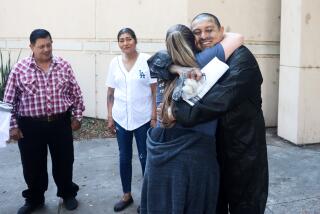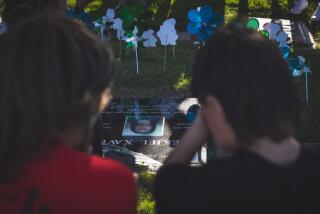Ft. Bragg investigates infant deaths
Reporting from Ft. — On April 15, 2009, Melissa Pollard’s two-month-old son, Jay’Vair, stopped breathing and died inside military housing on this sprawling Army base.
Three months later, on July 23, seven-month-old Ka’Mya Frey died suddenly while taking a nap in the same house. The baby was the daughter of Pollard’s brother and his fiancee, Bianca Outlaw, who were living temporarily with Pollard and her soldier husband.
Only later did Pollard and Outlaw learn from neighbors that another infant who had lived in the same house in 2007 died that year of an undetermined cause while with a babysitter in nearby Fayetteville, N.C.
“Unfortunately, our kids died before we had any idea what was going on with them,” Outlaw, 20, said Tuesday. “I mean, there has to be something in that house that’s causing healthy babies to get sick and die.”
According to Ft. Bragg officials, 10 infants have died suddenly while living in base housing since January 2007, including Jay’Vair and Ka’Mya. Autopsies were performed by the military for all 10, with the manner of death ruled “undetermined” in seven cases.
One death was attributed to sudden infant death syndrome, or SIDS. The deaths of Jay’Vair and Ka’Mya are still under investigation. Officials stressed that they had found no signs of foul play in any of the deaths, which involved infants aged two weeks to eight months.
Ft. Bragg authorities announced Tuesday that all 10 deaths were being reviewed to determine whether they are connected. The investigations are looking into environmental conditions, structural factors and hazardous materials.
Calling the deaths “a serious matter,” Brig. Gen. Michael X. Garrett, Ft. Bragg chief of staff, said Army investigators began reviewing them earlier this summer.
“What got my attention was … multiple deaths associated with one set of quarters,” Garrett said at a news conference, referring to the house where Jay’Vair and Ka’Mya died.
Chris Grey, a spokesman for the Army’s Criminal Investigation Command, said investigators had found no common link among the 10 deaths, which occurred in different base neighborhoods.
“At the end of the day, all these deaths, tragic as they are, could be attributed to sudden infant death syndrome” when the investigations are completed, Grey said. SIDS, is the unexplained death of a child under 1 year old.
Grey declined to provide details, saying he did not want to compromise investigations or unduly alarm military families.
Two of the 10 deaths occurred this year, Grey said. Three happened in 2009, three in 2008 and two in 2007. Three of the houses where infants died were new, three had been renovated and three had undergone minor renovations, said John Shay, the base housing manager.
The house where Jay’Vair and Ka’Mya died and the two houses where the two infants died this year are not occupied and will remain closed, officials said.
Other families live in the homes where other infants died, Shay said.
Officials said the air, building materials and other items were being tested at the units. Toxic black mold and contaminated drywall from China have been ruled out, they said.
“We cannot explain two deaths of children at one address, and that’s really the problem we’re trying to solve,” Garrett said.
Shay said he was not aware of a similar cluster of infant deaths at any other U.S. base.
More babies are born at Womack Army Medical Center at Ft. Bragg than on any other U.S. Army base — about 10,000 since Jan. 2007, officials said. With 10 known cases of SIDS over that period, base rates are probably “quite low,” said Col. Stephen Sicinski, the garrison commander.
But because many military babies are born off base and then move onto Ft. Bragg, computing accurate SIDS rates is difficult, he said. Nationally, the rate is about 0.5 SIDS deaths per 1,000 live births, according to the American SIDS Institute.
Ft. Bragg is home to about 6,200 families, with a total population of about 45,000, Sicinski said.
Col. Jeffrey Kingsbury, a physician who is chief of preventive medicine at Womack Army Medical Center, said possible SIDS factors include letting babies sleep on their stomachs, smoking in the home, objects left in cribs, extremely soft mattresses and metabolic disorders. About 2,500 U.S. deaths a year are attributed to SIDS, according to the American SIDS Institute.
Investigators are reviewing the infants’ medical histories, blood samples, autopsy reports and other evidence, Kingsbury said.
Outlaw said she and Pollard tried without success for more than a year to get information from military authorities about their babies’ deaths.
“Every time I’d talk to somebody, they’d tell me they didn’t know or they couldn’t tell me,” she said.
She said Ka’Mya was “healthy as a horse” until the family moved in with Pollard in late June 2009, two months after Pollard’s infant son died in the house. After a few weeks, Ka’Mya developed congestion, a runny nose and nagging cough.
When she went to awaken the infant from an afternoon nap, Ka’Mya was blue and unresponsive, Outlaw said.
Jamie B. Hernan, an attorney who represents Outlaw and Pollard, said the military should have been more forthcoming Tuesday about the investigations in order to reassure families with small children living at Ft. Bragg.
Hernan said Outlaw and Pollard wanted to know not only why their babies died, but whether other infants living in base housing are at risk.
“They appeared to suggest that it’s just that one housing unit that they can’t explain,” Hernan said of the military. “It’s more than that. There are just too many other deaths in other units.”
Garrett, who said he lived in base housing, told reporters that officials would inspect the house of any family that requested it. He promised to keep families informed.
“We’re going to get to the bottom of it,” he said.
More to Read
Sign up for Essential California
The most important California stories and recommendations in your inbox every morning.
You may occasionally receive promotional content from the Los Angeles Times.











